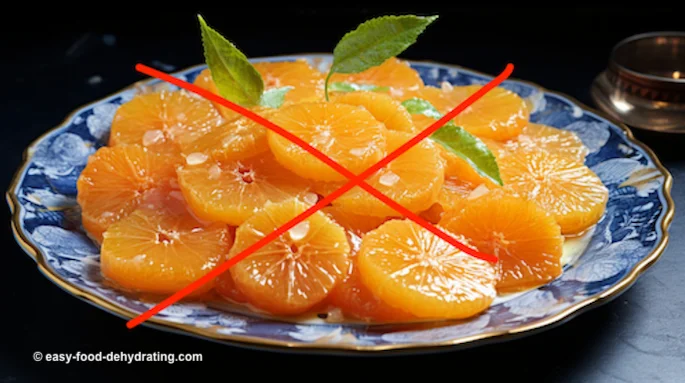What We Mean by “Dehydrate”
Here at Easy Food Dehydrating, “dehydrate” always means using an electric food dehydrator — the easy, reliable way to dry food at home.
- Home
- Dehydrating Fruits: Step-by-Step Guides by Type
- Pros and Cons of Dried Fruit
Pros and Cons of Dried Fruit:
What You Should Know Before Snacking

I’ll be honest, I used to think dried fruit was a guilt-free snack. I’d munch raisins like they were nothing — until I looked at the sugar content.
✅ Quick Answer: What are the pros and cons of dried fruit?
Here’s the deal: dried fruit sounds healthy—and it *can* be—but it’s also sneaky. Sure, it’s full of fiber and antioxidants, but it’s also loaded with sugar and easy to overeat. Keep it in check, and it’s a solid snack. Ignore the serving size? You might as well eat candy.
Whoa. It’s like nature’s candy, but sneakier.

So yeah, dried fruit has its ups and downs. Here’s the real scoop:
Dried Fruit: Helpful or Harmful? A Quick Breakdown
The Truth About Dried Fruit: The Good, the Bad & the Sugary
Is dried fruit healthy? Depends who you ask—and how big your handful is. Personally, I like it for hikes and long writing days, but I’ve also caught myself over-snacking more than once.
Here’s my take: it’s great because it lasts forever, doesn’t bruise in a backpack, and gives you a solid energy boost. But it’s also *really* easy to go overboard. A small handful? Great. A whole bag? You’ll regret it (ask me how I know).
What Happens to Fruit When You Dry It?
When you dry fruit, you're basically just removing the water—and what’s left is a smaller, sweeter, chewier version of the original. You can dry fruit the old-school way in the sun, or speed things up with a food dehydrator (I use a Nesco, Excalibur, or my Elite Gourmet dehydrator, depending on the batch).
But here’s the thing: no water means everything else gets concentrated, especially the sugar. So if you compare an ounce of dried fruit to an ounce of fresh, the dried stuff packs way more calories and sugar per bite.
Keep that in mind if you tend to eat it by the handful (ask me how I know… 😉).
Can Dried Fruit Really Boost Your Health?

It might surprise you, but dried fruit isn’t just sugar—it can actually pack a health punch. Many types are rich in polyphenols, which are antioxidants that help fight inflammation, support your heart, and protect your cells from damage.
Take prunes and dates, for example—great for digestion. And raisins? They've got compounds that can help with blood flow and circulation. Just goes to show: dried fruit isn’t all bad... as long as you don’t go overboard.
Dried vs. Candied Fruit: What’s the Sugar Bomb?

A lot of folks think dried fruit and candied fruit are basically the same—but they’re definitely not. Dried fruit is just that: fruit with the water taken out. It keeps its natural sugars and flavor.
Candied fruit, on the other hand? That’s fruit that’s been soaked in sugar syrup before drying. It’s more candy than fruit at that point. My dad used to love the stuff (especially those neon fruitcakes 😆), but now that I know what’s in it, we steer clear.
If you're trying to cut back on sugar, always look for unsweetened dried fruit (and dry your own fruit!). Skip the candied kind altogether.
Diabetic? Here’s How to Snack on Dried Fruit Safely
Dried fruit can be tricky if you’re managing blood sugar, but it’s not totally off-limits. The key is to watch portions and pair it smartly.
First off, always go for unsweetened dried fruit—no added sugar, no artificial sweeteners. Then stick to small servings. A tablespoon or two alongside some protein or healthy fat (like a handful of nuts or a slice of cheese) can help keep sugar spikes in check.
Avoid the big offenders like sweetened cranberries, banana chips, and dried mango—they're basically sugar bombs. And don’t forget to stay hydrated; water helps your body process sugars more smoothly.
Bottom line? You can still enjoy dried fruit—it just takes a little planning.
Is Dried Fruit Spiking Your Blood Sugar? Find Out Fast
Test your blood sugar levels 1-2 hours after eating dried fruit to see your individual tolerance levels.
Check out this BGM101 Blood Glucose Monitor Kit at Amazon.com*

As an Amazon Associate, I earn commission from qualifying purchases. The price you pay does not increase. Read disclosure here.
Overall, unsweetened dried fruits eaten in very small portions can fit into a diabetic diet - again, in moderation.
Not sure how much is too much? A registered dietitian can help you figure out the right portion sizes and dried fruit options that actually work for your body—especially if you're watching your weight or blood sugar.
Build Your Own Dried Fruit Trail Mix (Without the Guilt)
Try this simple trail mix recipe that combines the best of dried fruit and nuts for energy, protein, and flavor.

Ingredients:
- 1 cup raw almonds
- 1 cup raw cashews
- 1 cup raw pepitas (pumpkin seeds)
- 1⁄2 cup unsweetened dried cranberries
- 1⁄2 cup unsweetened dried cherries
- 1⁄2 cup raisins
- 1⁄4 cup dark chocolate chips (optional: Stevia-sweetened 55% cocoa)
Lily's Dark Chocolate baking chips with Stevia
Reduce SUGAR even more with these dark chocolate baking chips. I eat 'em all the time...
(well, not ALL the time! ... You know what I mean!)
As an Amazon Associate, I earn commission from qualifying purchases. The price you pay does not increase. Read disclosure here.
Here’s how I usually make mine (no measuring cups needed): I grab a big bowl, toss in a mix of almonds, cashews, and pepitas, then throw in a handful or two of dried cranberries and cherries. Sometimes raisins make the cut, sometimes not.
Then — chocolate. I almost always add dark chocolate chips, especially the Stevia ones from Lily’s. They’re kind of my weakness. Mix it up, scoop it into little snack bags, and toss a desiccant pack in there to keep it fresh. Otherwise, I *will* eat half the mix in one go. No shame.
🤔 Still Curious About Dried Fruit? Read These FAQs
Is dried fruit healthy?
Is dried fruit healthy?
Sometimes. It’s loaded with fiber and antioxidants—but also sugar. If you treat it like candy (which it kind of is), then yeah, it’s not great. Small portions are your friend.
Is dried fruit gluten-free?
Is dried fruit gluten-free?
Yep, it’s gluten-free—as long as you skip the weird store-bought ones with added stuff. Some brands sneak in coatings that can trip you up if you’re sensitive.
Can dried fruit cause gas?
Can dried fruit cause gas?
Oh yeah. The fiber’s great... until it isn’t. If you eat too much too fast, bloating is almost guaranteed. Start small and drink plenty of water.
What is FODMAP, and why does it matter?
What is FODMAP, and why does it matter?
It stands for some fancy digestive stuff (Fermentable Oligosaccharides, Disaccharides, etc.) that some people can’t handle well. Certain dried fruits are high in these, so if you’ve got tummy troubles, keep an eye on your reaction.
As you’ve seen, dried fruit isn’t all good or bad—it’s about balance and smart snacking. When enjoyed in small portions and paired with protein or healthy fats, it can be a flavorful, portable way to get your fiber and antioxidants.
And if you're ready to move beyond snacking and dive into delicious dried food meals, don’t forget to grab your free 5 Dried Food Recipes You'll Actually Love PDF (below). It features fan-favorite recipes like carrot soup, minestrone soup, split pea soup, spicy beef jerky, and banana cinnamon rolls—each one designed for convenience and flavor!
Get 5 Dried Food Recipes You'll Actually Love
Here's where you can get your copy of our all new
5 Dried Food Recipes (That Actually Taste Great)
They're my all-time favorite easy dried food meals!
Get it here right now.
For Free!
Before You Go...
If you enjoyed this page, tap the ❤️ in the lower right-hand corner.
It saves this page to your Grow bookmarks so you can find it again later.
You’ll also see quick share buttons to copy the link, post to Facebook,
or save it straight to Pinterest.
















